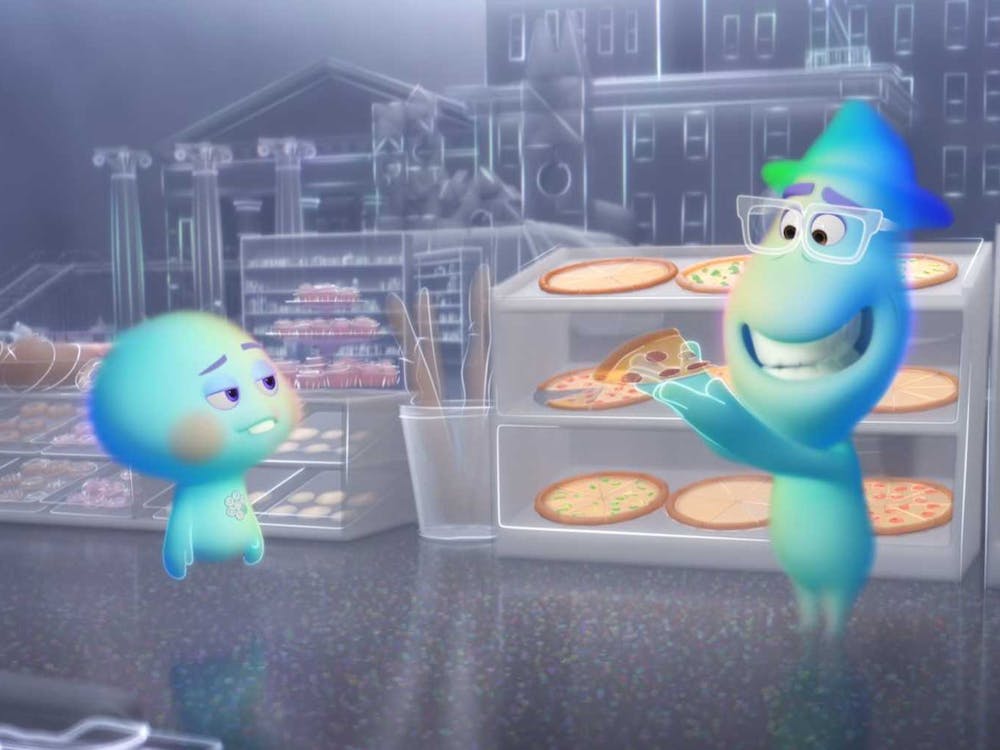“Soul” may be a Pixar film, but it deals with one of the most pressing anxieties for modern adults: What does it mean to follow your dream, to find your soul, your spark, in a world where dreams are, all too often, deferred?
Joe Gardner, voiced by Jaime Foxx, is the soft-smiling protagonist of “Soul” and the first Black protagonist of a Pixar movie. Clad in a black turtleneck and gray fedora, he dreams of becoming a legendary jazz pianist. All other routes for his career, including a potential stint as a middle school band teacher, seem bleak in comparison, despite his mother’s exasperated insistence that he find a stable, paying job.
Early on, it is unclear why this very real-life narrative needs to be animated, until the movie jolts the viewer with Joe’s sudden death-by-unmarked-pothole, splintering the rest of the story into two worlds: the rich realism of New York City; and the “Great Before,” a cotton candy-colored realm guided by benevolent line-art beings who prepare “unborn souls,” cute blue blobs with eyes and mouths, for their lives as humans. After his death, Joe, now an amorphous blue blob, lands on a slowly moving road, suspended in space, that channels into a glowing orb called the “Great Beyond.” Somehow (don’t think too hard) he is able to escape and venture on an interdimensional journey to recapture his life with the aid of an unborn soul known as 22. Voiced by Tina Fey, she is the 22nd soul to ever exist, but she has never been able to find her spark — which is the final requirement for souls to enter the world as human beings.
“Soul” feels like the older, darker cousin of “Inside Out,” which was also divided into two worlds and sought to illustrate our psychology. But where “Inside Out” posited a metaphor for emotion, “Soul” takes a more experimental route that asks instead of answers. Sure, the unborn souls are sorted into portals that determine their oversimplified personality traits (either “insecure” or “self-absorbed,” in one instance), but these are largely peripheral moments played for laughs. The heart of “Soul” lies in deep questions whose answers are only suggested: What makes a life worth living? What is a spark? How do we find it?
Joe Gardner assumes that his spark is identifiable: It is jazz. There is nothing else that can fulfill him, he believes, nothing else that can give his life meaning. Thankfully, however, this assumption is undermined. (For many, the pressure to identify a singular passion and wring out of it a life philosophy is, to say the least, anxiety-inducing.) In a “Freaky Friday”-type incident, 22 inhabits the body of Joe and Joe that of a chubby cat. While in the cat’s body, Joe witnesses, through 22’s first experience as a human, what he was missing about the point of living: the sight of twirling helicopter seeds, the smell of pizza and all the other relics of ordinary life that coat the world with a glow if you look closely enough. A spark, it turns out, is not one thing — it is ineffable, not a hobby nor an item but perhaps, rather, an approach to life or a cluster of sensations.
However, many Black viewers have noted that the decision of the movie to remove a Black character from his body and restrict his agency over his own life recalls racist tropes in animation’s past. Repeatedly, Black characters in animated movies have been transformed into animals or non-human beings for large portions of a movie’s duration. Throughout much of “Soul,” Joe Gardner is not living his own life — he is either a disembodied soul-blob or a talking cat. Joe’s life in New York City is the soul of the movie, yet quicksilver plot shifts dance around this potential for authentic representation.
Meanwhile, the animation, which was guided by a brain trust of Black animators and Kemp Powers, the first Black director of a Pixar film, has received praise from Black critics for its sumptuous realism and accuracy. Space and distance and glinting light in the streets of New York look nearly photographic, and segments of interdimensional travel fill the screen with post-modern scribblings and brilliant, entrancing light displays. Trent Reznor’s synthesizer soundscapes accentuate this aura of transcendence, this sense that even the smallest things on Earth are laden with heaven.
Unfortunately, though, the film does not transcend animation’s troubled history of racial representation. “Soul” unfolds a bit like a dream, and dreams, like river rapids, are messy, unpredictable and potentially dangerous. Some viewers, who let the current of “Soul” carry them downstream, may arrive at the end of the hour-and-fifty-minute film wet with calm and a renewed vigor in their orientation toward life. Others, however, may find the waters too muddy to warrant a trip in the first place.
Get The Chronicle straight to your inbox
Signup for our weekly newsletter. Cancel at any time.

